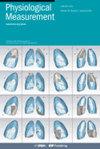Evaluation of transformation invariant loss function with distance equilibrium in prediction of imaging photoplethysmography characteristics.
IF 2.3
4区 医学
Q3 BIOPHYSICS
引用次数: 0
Abstract
Monitoring changes in human HRV (Heart Rate Variability) holds significant importance for protecting life and health.. Studies have shown that Imaging Photoplethysmography (IPPG) based on ordinary color cameras can detect the color change of the skin pixel caused by cardiopulmonary system. Most researchers employed deep learning IPPG algorithms to extract the Blood Volume Pulse (BVP) signal, analyzing it predominantly through the Heart Rate (HR). However, this approach often overlooks the inherent intricate time-frequency domain characteristics in the BVP signal, which cannot be comprehensively deduced solely from HR. The analysis of HRV metrics through the BVP signal is imperative. APPROACH In this paper, the transformation invariant loss function with distance equilibrium (TIDLE) loss function is applied to IPPG for the first time, and the details of BVP signal can be recovered better. In detail, TIDLE is tested in four commonly used IPPG deep learning models, which are DeepPhys, EfficientPhys, Physnet and TS_CAN, and compared with other three loss functions, which are MAE, MSE, NPCC. MAIN RESULTS The experiments demonstrate that MAE and MSE exhibit suboptimal performance in predicting LF/HF across the four models, achieving the Statistic of Mean Absolute Error (MAES) of 25.94% and 34.05%, respectively. In contrast, NPCC and TIDLE yielded more favorable results at 13.51% and 11.35%, respectively. Taking into consideration the morphological characteristics of the BVP signal, on the two optimal models for predicting HRV metrics, namely DeepPhys and TS_CAN, the Pearson coefficients for the BVP signals predicted by TIDLE in comparison to the gold-standard BVP signals achieved values of 0.627 and 0.605, respectively. In contrast, the results based on NPCC were notably lower, at only 0.545 and 0.533, respectively. SIGNIFICANCE This paper contributes significantly to the effective restoration of the morphology and frequency domain characteristics of the BVP signal.评估具有距离平衡的变换不变损失函数在预测成像照相心动图特征中的应用。
监测人体心率变异(HRV)的变化对于保护生命和健康具有重要意义。研究表明,基于普通彩色相机的成像血压计(IPGP)可以检测心肺系统引起的皮肤像素颜色变化。大多数研究人员采用深度学习 IPPG 算法提取血容量脉搏(BVP)信号,主要通过心率(HR)对其进行分析。然而,这种方法往往忽略了 BVP 信号中固有的错综复杂的时频域特征,仅从心率无法全面推导出 BVP 信号。本文首次将具有距离平衡(TIDLE)的变换不变损失函数应用于 IPPG,从而更好地恢复 BVP 信号的细节。实验结果表明,在四种常用的 IPPG 深度学习模型中,MAE 和 MSE 在预测 LF/HF 方面表现不佳,平均绝对误差(MAES)分别为 25.94% 和 34.05%。相比之下,NPCC 和 TIDLE 的结果更佳,分别为 13.51% 和 11.35%。考虑到 BVP 信号的形态特征,在预测心率变异指标的两个最佳模型(即 DeepPhys 和 TS_CAN)上,TIDLE 预测的 BVP 信号与黄金标准 BVP 信号相比的皮尔逊系数分别达到 0.627 和 0.605。相比之下,基于 NPCC 的结果明显较低,分别只有 0.545 和 0.533。
本文章由计算机程序翻译,如有差异,请以英文原文为准。
求助全文
约1分钟内获得全文
求助全文
来源期刊

Physiological measurement
生物-工程:生物医学
CiteScore
5.50
自引率
9.40%
发文量
124
审稿时长
3 months
期刊介绍:
Physiological Measurement publishes papers about the quantitative assessment and visualization of physiological function in clinical research and practice, with an emphasis on the development of new methods of measurement and their validation.
Papers are published on topics including:
applied physiology in illness and health
electrical bioimpedance, optical and acoustic measurement techniques
advanced methods of time series and other data analysis
biomedical and clinical engineering
in-patient and ambulatory monitoring
point-of-care technologies
novel clinical measurements of cardiovascular, neurological, and musculoskeletal systems.
measurements in molecular, cellular and organ physiology and electrophysiology
physiological modeling and simulation
novel biomedical sensors, instruments, devices and systems
measurement standards and guidelines.
 求助内容:
求助内容: 应助结果提醒方式:
应助结果提醒方式:


